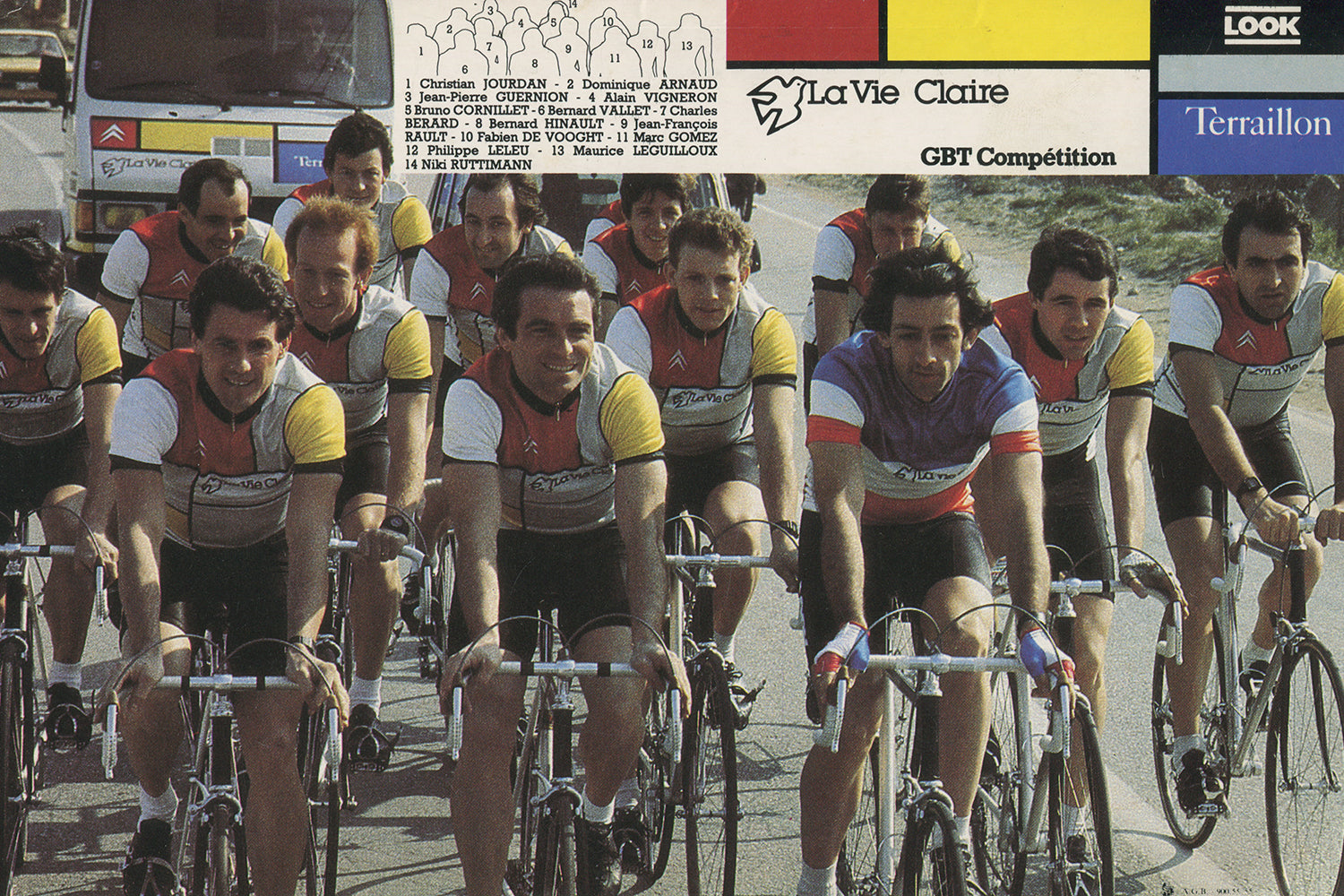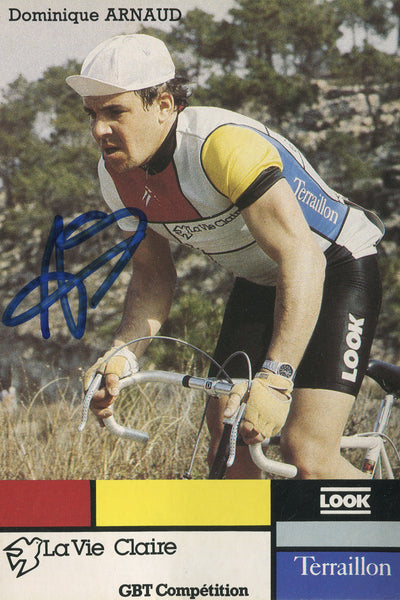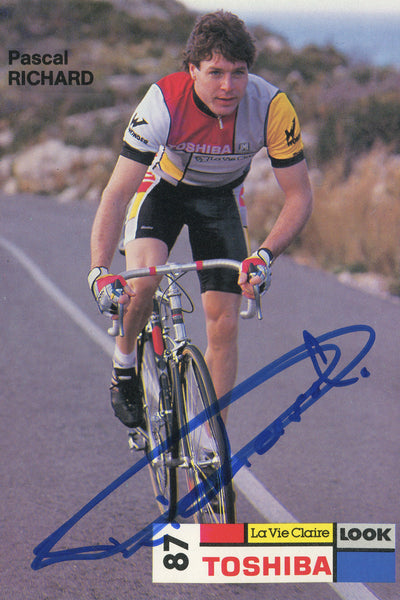QUALITY CYCLING CLOTHING SINCE 1996 - THE UK'S FIRST RETRO MANUFACTURER
QUALITY CYCLING CLOTHING SINCE 1996 - THE UK'S FIRST RETRO MANUFACTURER
RETRO APPAREL
COLLECTIONS
Cycling Clothing
ACCESSORIES
La Vie Claire Cycling Team
July 08, 2020 9 min read

Join cycling author & journalist William Fotheringham who looks back at the La Vie Claire cycling team in this fascinating insight into the history of the La Vie Claire team and it's iconic Mondrian-inspired jersey.
An early publicity still from the La Vie Claire team shows the two Bernards, Hinault and Tapie, on board a rather ropy looking tandem. Tapie, clad in casuals, bouffant hair blowing in the wind, sits in front; a sober-suited Badger is in the stoker position. It’s a good image for one of the whackiest and most important deals cycling has seen: a somewhat dodgy magnate out to have his fun, with one of the greats of the sport getting down to business in a serious way as his career ends. The third and most enduring element is missing from the picture but we’ll come to that in a moment.
The partnership between the two Bernards lasted for just three seasons, but between them they dragged cycling into the modern era. It was a marriage born of mutual need. In summer 1983, Hinault’s career was on the ropes. He had been forced to take a break for an operation on his achilles tendon; it was uncertain whether he would return to his best. While he was out, Cyrille Guimard, the manager who had mentored him throughout his career, and with whom he had won four Tours de France, had uncovered a new star: Laurent Fignon, who had unexpectedly won the Tour de France.
As Fignon recalled, when Hinault turned up at the after party at the end of the 1983 Tour, it was obvious from his demeanor that he was on the way out. Guimard didn’t just have Fignon lined up as the next Hinault, he also had Greg LeMond, who was a far brighter young prospect than Fignon. So no place for Hinault there - but who would want to hire an aging four-times Tour winner recovering from a major injury?

Bernard Hinault (La Vie Claire Radar Wonder) winning the 1984 Giro di Lombardia. Photo: Fotoreporter Sirotti.
The answer was: a man who specialized in buying up companies with a dubious future, turning them back into going concerns and then selling them on. Bernard Tapie was a former nightclub crooner - his name anglicized as Bernard Tapay - turned television salesman, who had begun rebooting bankrupt businesses in 1977. Like Terraillon (scales), Wonder (batteries) and Look (ski bindings), the health food chain La Vie Claire had been acquired for a single symbolic franc. The business model used to revive them entailed cutting costs, renegotiating debts and - critically for cycling history - diversification.
Hinault didn't attempt to pull the wool over Tapie’s eyes after the pair had been brought together by Sean Kelly’s team manager Jean de Gribaldy. The “Badger” told Tapie that his chances of getting back to his best were 50-50.
The magnate wasn’t bothered. His intentions were twofold: use Hinault’s celebrity status to raise his personal profile nationally, thus furthering his political and business goals, and to persuade the Badger to help his company Look expand from ski accessories into the cycling market. Look would use a radical pedal that did away the toeclips, replacing them with step-in, click-out attachments as used on ski boots.
It was classic Tapie: get the company to produce kit and sell it into a summer sport as well as a winter one.

La Vie Claire cycling team was launched in 1984 with Bernard Hinault and the reigning French Champion Marc Gomez as team leaders.
The partnership brought Tapie instant profile before Hinault had turned a pedal in anger. An initial press conference at the end of September 1983 drew nigh on 150 press, rather than the couple of dozen cycling specialists who would usually turn up for these things. The key line from Tapie was this: “Whether Hinault races or not is irrelevant, whether he wins or not doesn’t matter… I’m counting on him to make as much money as possible.” Welcome to the new world of 1980s cycling.
To build their new team in the space of a few months, the Bernards hired Philippe Crepel, formerly of La Redoute. He had a budget of about a million pounds to play with - twice that of La Redoute. Having seen all power at Renault invested in one man, Guimard, Hinault wanted a team where the roles of coach and director sportif were separate; as coach, he and Crepel hired Guimard’s tutor Paul Koechli, a bespectacled Swiss boffin; the team would be managed on the road by Hinault’s former team mate Maurice le Guilloux.
La Vie Claire Jersey
What’s missing from the tandem image is the bouncing child of this unusual marriage, the element which has given the team life beyond its seven year existence. La Vie Claire is probably best known now for its Mondrian-inspited cycling kit of multicolored squares, which fans still vote (in 2018 and in 2020) the finest cycling jersey design nigh on 37 years after it was conceived.
At the time the La Vie Claire jersey was radical. It changed the way cycling team jerseys were created. It has stood the test of time, in that people still want to buy it and wear it.
The term iconic should not be used lightly, but here it is justified.

This V&A postcard placed on the 1985 original wool La Vie Claire jersey was picked up by Rebecca (Prendas member of staff) at the Victoria & Albert Museum showing the Yves Saint Laurent Cocktail dress from the Mondrian Collection.
The linear designs of Dutch abstract artist Piet Mondrian, who died in 1944, had already been an inspiration in other areas - Hermès handbags in the 1930s, a best-selling Yves Saint Laurent collection in 1965, the logo of cosmetics company l’Oreal.
The design of the La Vie Claire jersey was born at a meeting in Paris’s Place de la Bourse involving Crepel, Koechli and a designer from the fashion group MicMac, another Tapie enterprise.
An initial design for a black jersey inspired by the All Blacks was turned down, and - so Crepel told me when I interviewed him for my Hinault biography The Badger - thoughts then turned to a “patchwork” design. “The stylist went to the Louvre and bought a Mondrian book,” Crepel recalled, “and then we worked out the design on a table in the bistro.”

The La Vie Claire jersey of 1985, Toshiba jersey of 1988 and the Toshiba jersey of 1990.
Hitherto, cycling jersey designs had usually placed sponsors’ names and logos in the chest/upperback/shoulder area, with size depending on their respective financial input. In a radical departure, the La Vie Claire jersey used blocks of red, white, blue and yellow - one for each of the major sponsors, Look, Terraillon, La Vie Claire, and Citröen, who were not a Tapie company but had been drawn in by the chance to take on major rivals Renault head to head.
The La Vie Claire jersey was groundbreaking in terms of design and construction. Back then every jersey was plain with just a bit of embroidery on the sleeves and neck. The Mondrian design totally changed that so that each jersey was like a work of art. It totally transformed the way in which we made jerseys.
Pietro Santini. cyclingnews.com.
The new style of jersey was facilitated by the fact that kit supplier Santini were moving from wool to polyester. That in turn meant the design could be printed onto the material, using a process called sublimation, rather than being stuck on or woven in as was the case with the classic designs on woollen jerseys; the change opened up cycling kit to the variety of designs we see to this day.
Greg Lemond joins Bernard Hinault at La Vie Claire
On the road, it took La Vie Claire most of 1984 to get going. Early season, Hinault gained most headlines for a confrontation with strikers at Paris-Nice which remains legendary to this day. He won the prologue time trial at the Tour but that was as good as it got with Fignon utterly rampant, to an extent that was embarrassing for the four-times winner. Philippa York recalled that because Guimard knew his former protege so deeply, he was an expert in winding Hinault up, provoking him into one tactical mistake after another.
Hinault’s relatively poor early season form had led to a crisis meeting two months in, at which it had been decided to reinforce the squad for 1985. Steve Bauer of Canada and the Dane Kim Andersen were on the list; Hinault had already tapped up LeMond at the Dauphiné, where he had been on the receiving end of a drubbing from a group of Colombian amateurs. At the Tour, LeMond was spirited away one evening from the Renault hotel by a dark-haired lady on a motorbike and made an offer he could not refuse: a million dollars over three years.
Here was another Tapie contribution to cycling’s 1980s culture change: the arrival of the big money. Another difference was the team’s multinational composition, facilitated by Tapie’s cash. The foundations of the team remained French but Americans, Dutch, Germans, Danes and - inevitably given Koechli’s presence - the Swiss would all play their part. In this, La Vie Claire was a precursor - albeit not the only one - of today’s international teams such as Jumo-Visma or Ineos.

Greg Lemond joined the La Vie Claire team in 1985, riding that year's Giro D'Italia. This archive photograph was taken at the stage start of the 7th stage from Cervia to Jesi. Photo: Fotoreporter Sirotti.
LeMond joined for 1985 but ironically by then Hinault had found his old form, triumphing in the Grand Prix des Nations and the Giro di Lombardia. The following two years were to be La Vie Claire’s best, with Fignon largely sidelined due to an achilles tendon operation from the start of 1985. The team dominated the Tour in both 1985 and 1986; Hinault and LeMond’s intra-team battle has been well documented, but what that reflected was two years of utter dominance for the team of the two Bernards.
In 1985, Hinault clinched the Giro-Tour double with a Giro taken on a course basically constructed for Moser; that was followed with a Tour in which the team won four stages, and led from stage four through Andersen and then Hinault.
La Vie Claire at the 1986 Tour de France
 Bernard Hinault (Right, Combination jersey) leads race leader and La Vie Claire team mate Greg Lemond on that famous stage from Briançon to the summit of l'Alpe d'Huez during the 1986 Tour de France. Photo: Fotoreporter Sirotti.
Bernard Hinault (Right, Combination jersey) leads race leader and La Vie Claire team mate Greg Lemond on that famous stage from Briançon to the summit of l'Alpe d'Huez during the 1986 Tour de France. Photo: Fotoreporter Sirotti.
The following year was even more impressive; the team led for 11 of the 22 stages through Hinault and LeMond, Hinault took three stages and the King of the Mountains to go with LeMond’s yellow jersey; of the Tour’s nine awards, La Vie Claire took six in total, with LeMond winning the combine and Andy Hampsten - hired that year from 7-Eleven - the white jersey. With Hampsten and Ruttiman, the team took four places in the first seven.
No team can maintain dominance on that scale. Hinault’s retirement at the end of 1986 left a void, and LeMond’s shooting accident early in 1987 compounded that. Jean-Francois Bernard - a stage winner in 1986 - performed as well as expected that July, winning the Ventoux time trial in the Tour, and holding yellow until Fignon, Pedro Delgado and Stephen Roche worked him over the following day. Koechli left in 1988, taking with him Bauer and the best Swiss riders, after which the team was backed by another Tapie company, Toshiba, and the team kit was amended with diagonal stripes replacing the Mondrian cubes. By then, it had become essentially another French team, although in its final season, 1991, the star was Swiss: Tony Rominger as well as a young Laurent Jalabert.
As for Bernard Tapie, he scaled the heights in France, buying Olympique Marseille and Adidas, but also became embroiled in a financial scandal, winding up in jail for 6 months.
Most recently, he has become involved - among other things - in the newspaper La Provencale, which sponsored the Tour de la Provence, with a leader’s jersey that bore a remarkable resemblance to the La Vie Claire team colours of 1984.

Roland Leclerc (Toshiba) prepares his kit prior to the start of the Giro del Lazio in 1990. Photo: Fotoreporter Sirotti.
Buy the La Vie Claire Retro team cycle clothing by Santini available at Prendas Ciclismo.
Further Reading
If you have enjoyed reading William Fotheringham's latest blog for us, we have a selection of previously published stories for you to enjoy.
Fotheringham is also one of many talented and experienced sports writers who have teamed up to create lacourseentete.com which will publish a range of articles written by those that have covered 200+ Grand Tours.
La Vie Claire Team Postcards from our collection

After starting his career at Reynolds, Dominique Arnaud move to the Puch–Wolber–Campagnolo team for two seasons before moving to the La Vie Claire team.

This Toshiba La Vie Claire postcard from the 1987 season is signed by Pascal Richard who went on to become the 1996 Olympic RR Champion at the Atlanta Games.

Fabrice Philipot joined the Toshiba Cycling Team in 1988 after 16 victories the previous three seasons in the amateur peloton. He went onto win the young rider competition at the 1989 Tour de France.
Also in News and articles from Prendas Ciclismo

Prendas' Best-Selling Caps of 2024
January 21, 2025 4 min read
With 2024 in the books, we're looking back at your favourite caps of the year. From cult classic movies to the jungle with a whole lot of Italian flair, check out our best-sellers and grab a new cap!

Vas-y Barry! Hoban wins Ghent-Wevelgem for Gan Mercier Hutchinson
May 15, 2024 8 min read
In an extract from his autobiography, Vas-y Barry, the only British winner of Ghent-Wevelgem, Barry Hoban tells how he won the cobbled classic in 1974, beating Eddy Merckx and the cream of Belgian cycling.

Our Best Selling Caps of 2023
January 15, 2024 4 min read
We know caps here at Prendas Ciclismo, and we know that you love all the styles we have on offer. So every year, we look back at our best-selling cycling caps for the previous year for you to discover a few new styles. Is your favourite cycling cap featured on our list? Read on and see!
Subscribe
Sign up to get the latest on sales, new releases and more …



